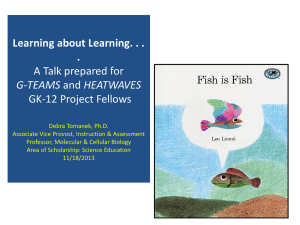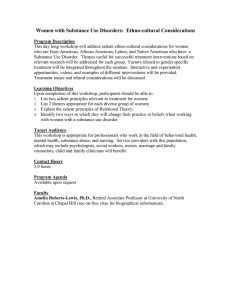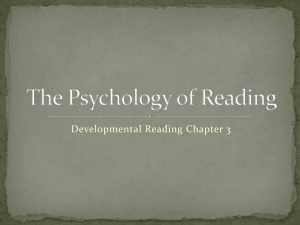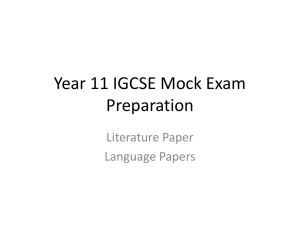How Does Visual Attention Differ Between Experts and Adrian Carmichael
advertisement
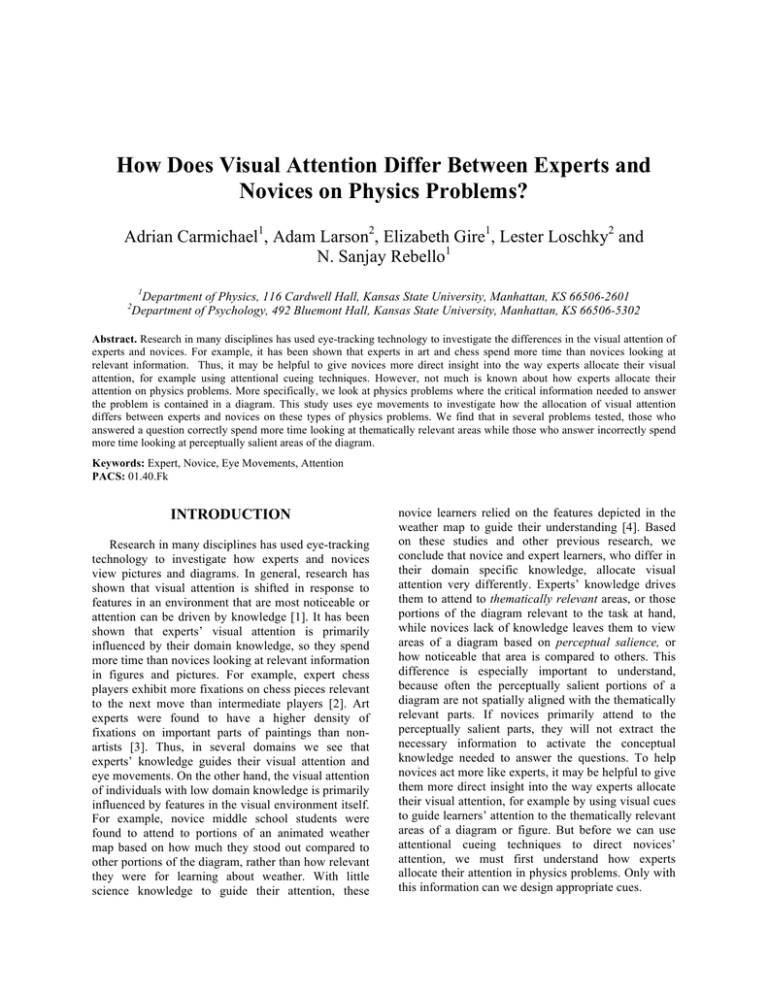
How Does Visual Attention Differ Between Experts and Novices on Physics Problems? Adrian Carmichael1, Adam Larson2, Elizabeth Gire1, Lester Loschky2 and N. Sanjay Rebello1 1 2 Department of Physics, 116 Cardwell Hall, Kansas State University, Manhattan, KS 66506-2601 Department of Psychology, 492 Bluemont Hall, Kansas State University, Manhattan, KS 66506-5302 Abstract. Research in many disciplines has used eye-tracking technology to investigate the differences in the visual attention of experts and novices. For example, it has been shown that experts in art and chess spend more time than novices looking at relevant information. Thus, it may be helpful to give novices more direct insight into the way experts allocate their visual attention, for example using attentional cueing techniques. However, not much is known about how experts allocate their attention on physics problems. More specifically, we look at physics problems where the critical information needed to answer the problem is contained in a diagram. This study uses eye movements to investigate how the allocation of visual attention differs between experts and novices on these types of physics problems. We find that in several problems tested, those who answered a question correctly spend more time looking at thematically relevant areas while those who answer incorrectly spend more time looking at perceptually salient areas of the diagram. Keywords: Expert, Novice, Eye Movements, Attention PACS: 01.40.Fk INTRODUCTION Research in many disciplines has used eye-tracking technology to investigate how experts and novices view pictures and diagrams. In general, research has shown that visual attention is shifted in response to features in an environment that are most noticeable or attention can be driven by knowledge [1]. It has been shown that experts’ visual attention is primarily influenced by their domain knowledge, so they spend more time than novices looking at relevant information in figures and pictures. For example, expert chess players exhibit more fixations on chess pieces relevant to the next move than intermediate players [2]. Art experts were found to have a higher density of fixations on important parts of paintings than nonartists [3]. Thus, in several domains we see that experts’ knowledge guides their visual attention and eye movements. On the other hand, the visual attention of individuals with low domain knowledge is primarily influenced by features in the visual environment itself. For example, novice middle school students were found to attend to portions of an animated weather map based on how much they stood out compared to other portions of the diagram, rather than how relevant they were for learning about weather. With little science knowledge to guide their attention, these novice learners relied on the features depicted in the weather map to guide their understanding [4]. Based on these studies and other previous research, we conclude that novice and expert learners, who differ in their domain specific knowledge, allocate visual attention very differently. Experts’ knowledge drives them to attend to thematically relevant areas, or those portions of the diagram relevant to the task at hand, while novices lack of knowledge leaves them to view areas of a diagram based on perceptual salience, or how noticeable that area is compared to others. This difference is especially important to understand, because often the perceptually salient portions of a diagram are not spatially aligned with the thematically relevant parts. If novices primarily attend to the perceptually salient parts, they will not extract the necessary information to activate the conceptual knowledge needed to answer the questions. To help novices act more like experts, it may be helpful to give them more direct insight into the way experts allocate their visual attention, for example by using visual cues to guide learners’ attention to the thematically relevant areas of a diagram or figure. But before we can use attentional cueing techniques to direct novices’ attention, we must first understand how experts allocate their attention in physics problems. Only with this information can we design appropriate cues. Previous research on how experts and novices allocate visual attention in physics is limited. In one study, introductory physics students’ and physics professors’ eye movements were studied when comparing current and voltage drop in different parts of DC circuits. They found that novices followed the shortest path between resistors in the circuit. One expert exhibited a gaze path that matched the path of the current in the circuit, while none of the novices displayed this pattern [5]. Here, experts and novices allocated their visual attention differently, though no connection has been made to these differences in eye movements and the salience or relevance of each portion of the circuit diagram. In another study, experts and novices were shown pairs of physics diagrams and subsequently given a memory test. Overall, experts were more likely to remember the thematically relevant portions of the diagram. In some instances, novices remembered more features of a diagram when these features were not physically meaningful [6]. The present study seeks to extend this work into different domains of physics and specifically look at how experts and novices attend to different areas of a diagram using eye movements. We hope to answer the research question; “How does expertise affect the fixation time in perceptually salient versus thematically relevant areas in a figure?” thematically relevant elements of the diagram, while the curved track is the perceptually salient element. Eye movements were recorded with an Eye Link 1000 eye tracking system (http://www.srresearch.com/). In this study participants utilized a chin and forehead rest and there was an average accuracy of 0.25° to 0.50° of visual angle. Participants’ verbal explanations and gestures were recorded with a Flip video camcorder. FIGURE 1. Problem 1 used in study. METHOD Participants in the study were 22 individuals, two females and 20 males, with two different levels of expertise. There were nine expert participants who were PhD students in physics and had taught an introductory physics course or acted as a teaching assistant for an introductory physics lab. The 13 novices were enrolled in an introductory psychology course at a large public university in the Midwest. All of the novices had taken at least one physics course in high school, though some had taken an introductory physics course at the university level as well. They participated in the study for course credit. The materials consisted of 10 multiple choice conceptual physics problems covering various topics in introductory physics including energy (e.g. Fig. 1), kinematics (e.g. Fig. 2 and Fig. 3), and circuits. Each problem contained a diagram that had a thematically relevant visual component that students needed to attend to in order to correctly answer the question. For example, in problem 1 (Fig. 1), to compare the speeds of cart A and cart B at the final position, one must attend to the start and end heights of both tracks using the picture and ignore the shape of the track. So, the heights of the start and end points of the track are the FIGURE 2. Problem 4 used in study. FIGURE 3. Problem 7 used in study. Procedure Each participant took part in an individual session which was between 20 to 40 minutes long. At the beginning, we gave participants a short explanation of what to expect during the session. The participants were seated at a computer and the eye tracking system was calibrated to the individual using a nine-point calibration and validation procedure. If the validation was accurate to under 0.50° of visual angle, the participant would begin the experiment. If the validation did not meet this mark, the calibration and validation was run again until successful. Next, the participant was instructed to silently answer 10 multiple-choice questions, with their head on a headrest, while their eye movements were recorded. The participant indicated their answer to each question using number keys on the keyboard. Finally, each participant was asked to provide a verbal cued retrospective report [7] for which they were shown a replay of their eye movements on each problem and asked to explain their thought process. Participants could choose to watch the replay of their eye movements for a problem in silence and then provide an explanation or watch the eye movements and provide an explanation concurrently. Participants were not given any time limit for answering the questions and providing the verbal reports. The fixation time in the AAOI for each participant on each problem was determined from eye tracking data. To account for any differences in the total viewing time on each problem, the fixation time across the perceptually salient and thematically relevant AAOI’s were divided by the total viewing time for the diagram on a given problem to get the percentage of time an individual spent in a particular AAOI. For each problem, the percentage of time spent in each type of interest area was compared between students who answered the problem correctly and those who did not. This grouping was chosen because we observed a crossover in expertise between the graduate students and the introductory psychology students, which varied by question. In listening to the retrospective reports, we found that there were questions where some of the graduate students gave novice like answers and some of the introductory psychology students gave expert like answers. Thus, for the purpose of this study we redefine expertise on a problem-by-problem basis and classify two treatment groups based on correct and incorrect answers. Data Analysis To analyze participants’ eye movements, we created areas of interest (AOI’s) which specified areas of the diagram that were used to determine the fixation time, i.e. the total amount of time the participant spent looking at a given region (e.g. Fig. 4). There were two types of AOI’s defined for a subset of the problems, these types being perceptually salient AOI’s and thematically relevant AOI’s. Three independent raters, one physics professor and two PhD students in physics, were given a definition for each type of interest area and asked to draw out each type of AOI on a paper copy of the problems. We chose to predefine the AOI’s in order to test our specific hypothesis that novices spend more time looking at perceptually salient areas of a diagram and experts spend more time looking at thematically relevant areas. The AOI definitions from the raters were compared, and the five problems with strongest agreement between raters were analyzed in this study. There were several problems where the thematically relevant and perceptually salient AOI’s were in more than one location on the diagram. In this case we combined all AOI’s of one type into an aggregate area of interest (AAOI). FIGURE 4. Problem 10 used in study. Perceptually salient interest area along slope. Thematically relevant interest area along height of hill. RESULTS & DISCUSSION An ANOVA with correctness of answer as the independent variable and percentage of time for both of the AAOI types as the dependent variables was conducted for five different problems. These problems tested knowledge of graphing kinematic quantities, energy concepts, and speed. On problem 1 (Fig. 1) the ANOVA showed a significant difference between the correct and incorrect responders in the perceptually salient AAOI, F(1,20)=12.1, p=.002. There was no significant difference for percentage of time spent in the thematically relevant AAOI. On problem 4 (Fig. 2) the ANOVA revealed that participants who answered this question correctly had significantly higher percentages of fixation time in the thematically relevant AAOI’s, F(1,19)=18.2, p<.001 and those who answered incorrectly had higher percentages of fixation time in the perceptually salient AAOI F(1,19)=8.4, p=.002. On problem 7 (Fig. 3) the ANOVA showed that those who answered the question correctly had significantly longer percentage of fixation time in the thematically relevant AAOI F(1, 20)=4.5, p=.047 and those who answered incorrectly spent more time looking in the perceptually salient AAOI F(1,20)=5.6, p=.028. For problem 10 (Fig. 4) the ANOVA showed that once again, those who got the problem correct had significantly longer percentages of fixation time in thematically relevant AAOI’s than those who got the problem wrong F(1,20)=4.8, p=.041. There was no significant difference between the percentages of fixation time of each group in the perceptually salient AAOI. Mean percentage of fixation duration and standard deviations for the correct and incorrect responders for each question are shown in Table 1. TABLE 1. Mean percentage time spent (± SD) for thematically relevant and perceptually salient AAOI’s for participants who answered the question correctly/incorrectly. Thematically Relevant AAOI Prob. 1 Prob. 4* Prob. 7* Prob. 10* Answered Correctly Answered Incorrectly 26.6 (± 16.1) (n=11) 46.6 (± 8.2) (n=12) 29.9 (± 14.2) (n=13) 26.0 (± 13.9) (n=10) 21.4 (±12.2) (n=11) 25.8 (± 18.3) (n=9) 18.0 (± 10.8) (n=9) 14.3 (± 11.0) (n=12) Perceptually Salient AAOI Answered Correctly Answered Incorrectly 10.5 (± 8.2) Prob. 1* (n=11) 19.2 (± 8.2) Prob. 4* (n=12) 12.8 (±9.0) Prob. 7* (n=13) 46.4 (± 17.1) Prob. 10 (n=12) *indicates significant difference, p <.05 31.5 (± 18.3) (n=11) 29.0 (± 6.9 ) (n=9) 25.3 (±15.8) (n=9) 52.9 (± 19.3) (n=10) CONCLUSION Our study compared the percentage of fixation time in the thematically relevant and perceptually salient aggregate areas of interest between participants who answered a physics question correctly and those who answered the same question incorrectly. We found that on three out of four problems analyzed, participants who correctly answered the question spent more time looking at the thematically relevant areas of the diagrams than those who answered the same question incorrectly. There were also three problems where there was a difference between the correct and incorrect responders in the fixation time in the perceptually salient portions of the diagrams. Thus, there is some evidence that supports previous findings in other domains that experts spend more time than novices looking at thematically relevant elements of a diagram and novices spend more time looking at perceptually salient areas. Eye movements for problems 1 and 10 will be further analyzed to determine why we did not see the same pattern of differences in fixation times between correct and incorrect responders as in the other problems. FUTURE WORK This study lays the foundation for future work in guiding novices’ attention using various cueing techniques. We have confirmed that the most noticeable visual features of the diagram influence participants who answer incorrectly. In our next study, we hope to add additional noticeable features to the diagrams in the form of visual cues to guide novices’ attention to the relevant portions of the diagram. The visual cues will be designed to mimic the areas of the diagram experts in this study spent most time looking at. We predict that attending to these thematically relevant portions of the diagram will help novice learners activate the correct prior knowledge and answer the question correctly. REFERENCES 1. T. van Gog, H. Jarodzka, K. Scheiter, P. Gerjets & F. Paas, Computers in Human Behavior 25, 785–791 (2009). 2. J. R. Antes & A. F. Kristjanson, Perceptual and Motor Skills 73, 893-894 (1991). 3. N. Charness, E. M. Reingold, M. Pomplun & D.M. Stampe, Memory and Cognition 29, 1146-1152 (2001). 4. R.K. Lowe, Learning and Instruction 12, 157-176 (2003). 5. D. Rosengrant, C. Thomson & T. Mzoughi, AIP Conference Proceedings 1179, Ann Arbor, Michigan, 2009, pp. 249-252. 6. A. Feil & J. Mestre, AIP Conference Proceedings 951, Greensboro, North Carolina, 2007, pp. 100-103. 7. T. van Gog, F. Paas, J.J. van Merrienboer & P. Witte, Journal of Experimental Psychology: Applied 11, 237244 (2005).
